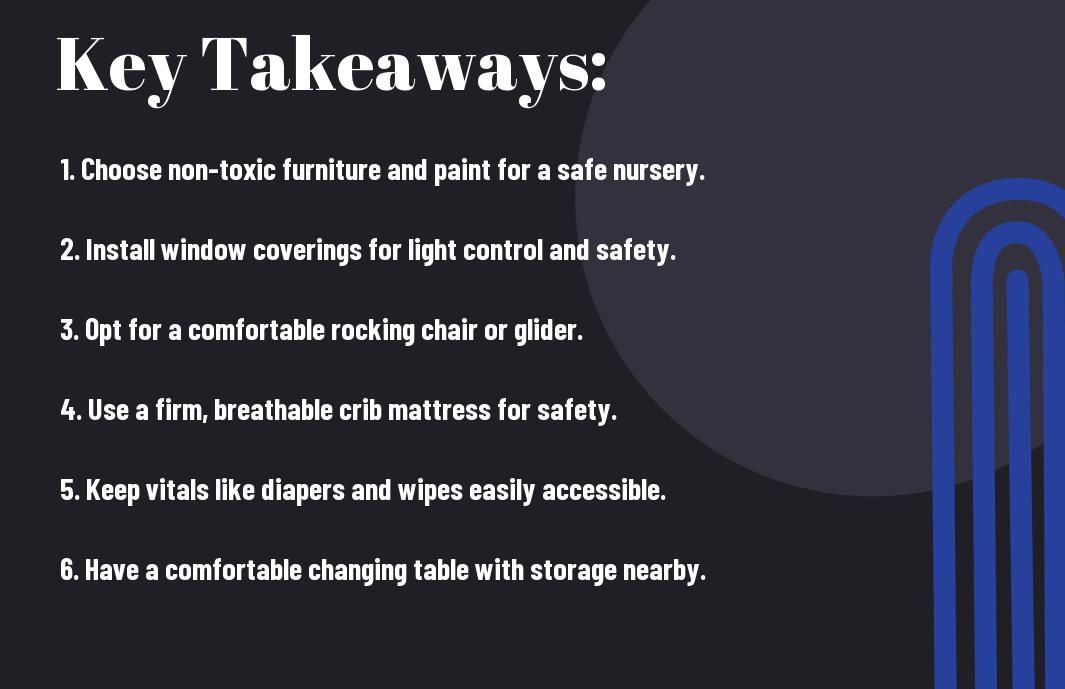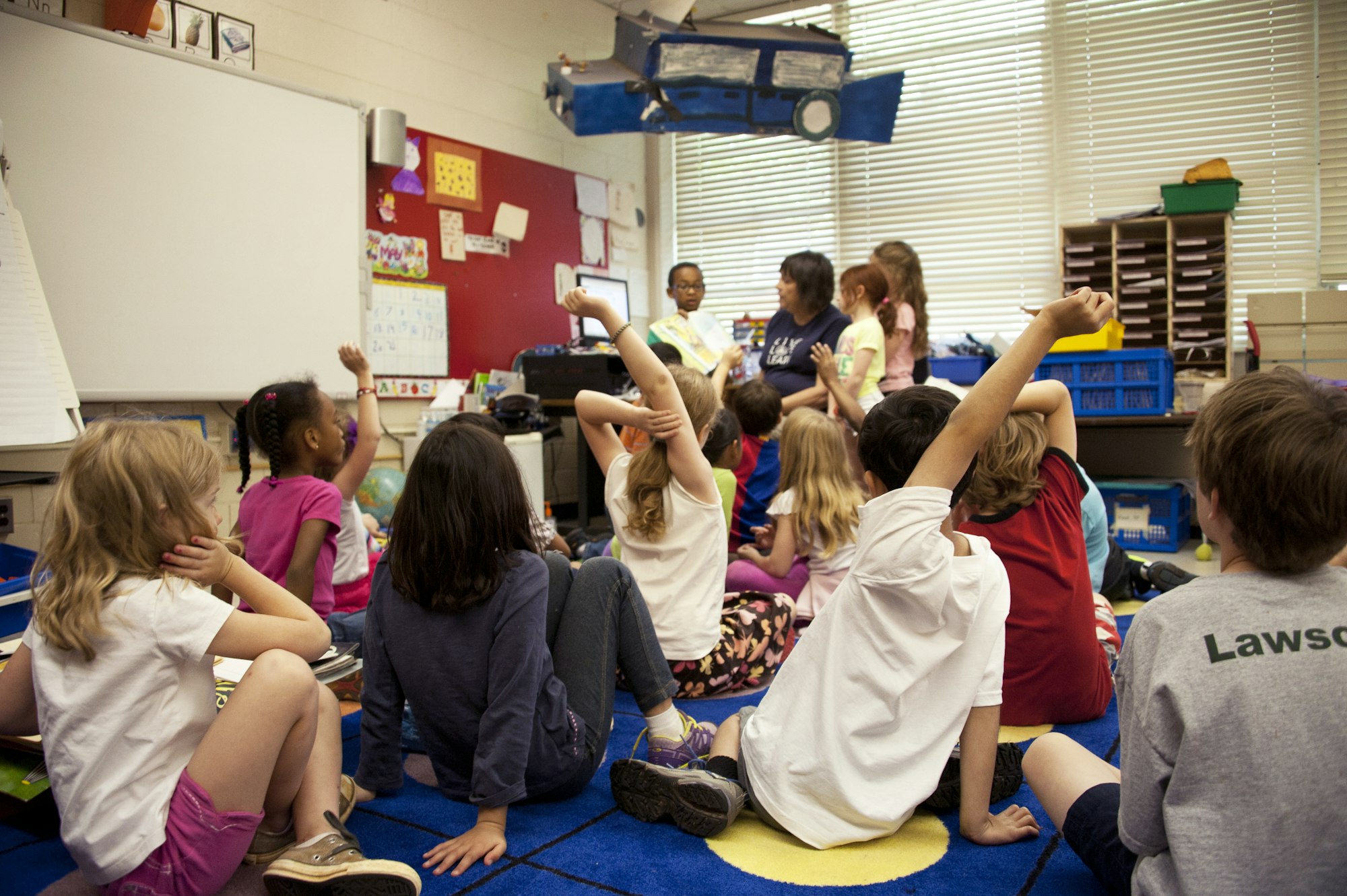Many new parents often find themselves overwhelmed with the task of setting up a nursery for their little one. It is crucial to create a safe and comfortable environment for the baby to thrive and grow in. This comprehensive checklist covers all the imperative items and considerations you need to keep in mind when preparing your nursery.
Key Takeaways:
- Priority on Safety: Always ensure the nursery is a safe environment for the baby.
- Comfort is Key: Create a cozy and comfortable space that promotes relaxation and sleep.
- Essential Items Checklist: Have all necessary items like crib, changing table, soft bedding, and baby monitor ready for the nursery.


Planning and Design
Assessing Your Space
The first step in creating a safe and comfortable nursery is to assess the space you have available. Consider the size of the room and how you can optimize it for both functionality and aesthetics. Take into account the location of windows, electrical outlets, and doors to ensure that the layout is conducive to a safe environment for your baby.
Color Schemes and Themes
When considering designing a nursery, color schemes and themes play a crucial role in creating a soothing and stimulating environment for your little one. Choosing the right colors can have a significant impact on your baby's mood and behavior, so it's important to select hues that promote a sense of calmness and security.
It is recommended to opt for soft pastel colors such as light blues, greens, and pinks, which can create a tranquil atmosphere. Additionally, incorporating natural elements like wood accents or botanical prints can add a sense of warmth and comfort to the nursery.
The Essentials Checklist
Now that you are preparing to set up your nursery, it is crucial to ensure that every item chosen meets safety standards and provides the necessary comfort for your little one. The following checklist outlines the necessary items you will need to create a safe and comfortable nursery for your baby.
Crib and Mattress Safety
For the crib and mattress safety, it is imperative to choose a crib that meets current safety standards, with slat distances no wider than 2-3/8 inches to prevent infant head entrapment. The mattress should be firm to reduce the risk of Sudden Infant Death Syndrome (SIDS) and fit snugly within the crib frame without any gaps. Avoid using soft bedding, pillows, or crib bumpers which can pose suffocation hazards to the baby.
Bedding and Sleep Accessories
The bedding and sleep accessories in the nursery should include a fitted crib sheet that is the right size for the mattress and is securely fastened in place. Additional items like sleep sacks or swaddles can help keep your baby warm and secure during sleep, reducing the risk of loose blankets covering their face. Avoid using plush toys or pillows in the crib to minimize the risk of suffocation or SIDS.
The choice of bedding and sleep accessories directly impacts your baby's safety and comfort during sleep. Opt for breathable fabrics such as organic cotton to prevent overheating and promote better air circulation within the crib.
Storage Solutions for Nursery
Crib drawers, under-crib storage bins, or wall-mounted shelves can provide efficient storage solutions for necessary baby items like diapers, wipes, and clothing within easy reach. Keeping the nursery organized and clutter-free not only maximizes space but also reduces the risk of tripping hazards.
Cribs with built-in storage options or versatile changing tables with drawers can help optimize space in the nursery while keeping all necessities within arm's reach. Proper organization ensures a safe and functional environment for both the baby and caregiver.


Comfort Measures
Optimal Room Temperature and Humidity
For optimal room comfort in your baby's nursery, it is vital to monitor the room temperature and humidity levels. Maintaining a temperature between 68-72 degrees Fahrenheit (20-22 degrees Celsius) is recommended for a comfortable and safe sleeping environment. Humidity levels should ideally range between 30-50% to prevent dryness or excess moisture in the air.
| Temperature | Humidity |
| 68-72°F (20-22°C) | 30-50% |
Lighting and Sound Considerations
Room lighting and sound can greatly impact your baby's comfort and sleep quality. When setting up the nursery, consider using soft, adjustable lighting options such as dimmable lamps or night lights to create a soothing environment. Avoid bright overhead lights that can be harsh on your baby's eyes. Additionally, controlling external sounds by using white noise machines or gentle lullabies can help create a calming atmosphere for your little one.
It is crucial to ensure that the nursery is a quiet and peaceful space to promote relaxation and restful sleep for your baby. Excessive noise and bright lights can disrupt your baby's sleep patterns and make it challenging for them to settle down.
Safety First
Babyproofing the Nursery
All new parents want to ensure their nursery is a safe haven for their little one. The first step in creating a safe environment is babyproofing the nursery. Cover electrical outlets, secure furniture to the wall to prevent tipping, and place safety locks on drawers and cabinets to keep hazardous items out of reach. Be sure to also use cordless window coverings to prevent any strangulation hazards.
Safe Toys and Play Equipment
An vital aspect of creating a safe nursery is providing safe toys and play equipment. Ensure that all toys are age-appropriate and do not contain any small parts that could be a choking hazard. Inspect toys regularly for any broken or loose parts that could pose a danger to your child. Consider choosing toys made from non-toxic materials and free from harmful chemicals.
Safe Toys and Play Equipment are not only vital for preventing accidents but also for promoting healthy development and play. Choose toys that encourage sensory exploration, motor skills development, and imaginative play. Engage in playtime with your child to ensure they are using toys safely and correctly.
Health and Hygiene
Choosing Non-toxic and Hypoallergenic Materials
The safety and well-being of your baby are paramount when selecting materials for their nursery. Keep in mind that babies have delicate skin and developing respiratory systems, making them more susceptible to harmful chemicals and allergens. Opt for cribs, bedding, rugs, and other nursery crucials that are made from non-toxic and hypoallergenic materials to minimize the risk of skin irritations, respiratory issues, and other health concerns.
Ensuring Proper Ventilation and Cleanliness
Hygiene is crucial in maintaining a safe and healthy nursery environment for your baby. Keep the nursery well-ventilated to reduce the buildup of indoor pollutants, mold, and mildew. Regularly dust, vacuum, and clean all surfaces in the nursery to prevent the accumulation of dust mites and other allergens. Consider using an air purifier to ensure proper ventilation and cleanliness and promote better air quality.

Additional Considerations
Incorporating Technology in the Nursery
Unlike the traditional nursery setup, modern nurseries can benefit from the incorporation of technology to enhance safety and convenience. Consider investing in a baby monitor with video capabilities to keep an eye on your little one even when you're not in the room. Additionally, smart thermometers and humidifiers can help you monitor and maintain the ideal conditions in the nursery for your baby's comfort.
Creating a Nursing or Feeding Area
One imperative element of a nursery is a dedicated nursing or feeding area. This space should be comfortable and equipped with everything you need for feeding sessions. Consider investing in a comfortable nursing chair or glider, a side table to hold imperatives like burp cloths and feeding supplies, and a soft rug to rest your feet on during long nursing sessions.
Considerations: When setting up a nursing or feeding area, ensure it is well-lit to prevent any accidents during nighttime feedings. Organize the area with storage solutions to keep imperative items within reach, making feeding sessions more manageable. Choose a chair or glider that provides adequate support for your back and arms to prevent discomfort during long feeding sessions.
Summing up
So, creating a safe and comfortable nursery is imperative for the well-being of your baby. By following this checklist of imperatives, you can ensure that your nursery is a cozy and secure space for your little one to grow and thrive. Remember to prioritize safety measures, invest in quality furniture and bedding, and personalize the space with thoughtful decor to make it a welcoming environment for both you and your baby.
FAQ
Q: Why is creating a safe nursery important?
A: Creating a safe nursery is crucial to ensure your baby's well-being. Babies spend a significant amount of time in their nursery, so a safe environment is important to prevent accidents and promote healthy development.
Q: What are the important items needed for a nursery?
A: Some important items for a nursery include a crib with a firm mattress, a changing table with safety straps, a comfortable glider or rocking chair for feedings, a dresser for storage, and a baby monitor for peace of mind.
Q: How can I make the nursery comfortable for my baby?
A: To make the nursery comfortable for your baby, consider adding soft bedding, soothing colors, a night light for gentle illumination, and a sound machine for white noise. Additionally, keep the room well-ventilated and at a comfortable temperature to ensure your baby sleeps soundly.

